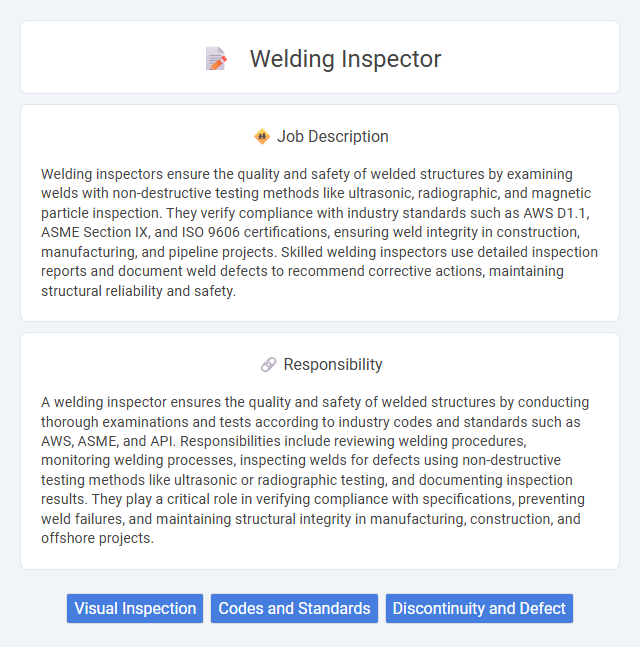
Welding inspectors ensure the quality and safety of welded structures by examining welds with non-destructive testing methods like ultrasonic, radiographic, and magnetic particle inspection. They verify compliance with industry standards such as AWS D1.1, ASME Section IX, and ISO 9606 certifications, ensuring weld integrity in construction, manufacturing, and pipeline projects. Skilled welding inspectors use detailed inspection reports and document weld defects to recommend corrective actions, maintaining structural reliability and safety.
Individuals with strong attention to detail and good visual acuity are likely to be well-suited for a welding inspector role, as the job requires careful examination of weld quality and adherence to safety standards. Candidates who possess analytical skills and a thorough understanding of welding processes may find it easier to identify defects and ensure compliance with industry regulations. Those who prefer hands-on work and have the ability to work in various environments, including construction sites or manufacturing facilities, are probably more compatible with the demands of this position.
Qualification
A Welding Inspector must possess certification such as AWS Certified Welding Inspector (CWI) or an equivalent industry-recognized credential to ensure expertise in welding standards, techniques, and codes. A strong background in metallurgy, welding processes, and non-destructive testing methods is essential for accurate inspection and quality control. Proficiency in reading blueprints, welding procedures, and adherence to safety regulations are critical qualifications for maintaining compliance in construction and manufacturing industries.
Responsibility
A welding inspector ensures the quality and safety of welded structures by conducting thorough examinations and tests according to industry codes and standards such as AWS, ASME, and API. Responsibilities include reviewing welding procedures, monitoring welding processes, inspecting welds for defects using non-destructive testing methods like ultrasonic or radiographic testing, and documenting inspection results. They play a critical role in verifying compliance with specifications, preventing weld failures, and maintaining structural integrity in manufacturing, construction, and offshore projects.
Benefit
Welding inspectors will likely benefit from competitive salaries and strong job security due to the high demand for quality assurance in construction and manufacturing industries. Opportunities for career advancement and professional certifications may enhance earning potential and broaden skill sets. The role often offers the chance to work on diverse projects, fostering continuous learning and specialized expertise.
Challenge
Welding inspectors likely face significant challenges in ensuring compliance with stringent safety standards and welding codes. The complexity of evaluating various welding techniques and materials requires a high level of technical expertise and meticulous attention to detail. The probability of encountering dynamic work environments makes adaptability and problem-solving crucial skills for successfully managing inspection duties.
Career Advancement
A Welding Inspector plays a critical role in ensuring the integrity and safety of welded structures across industries like construction, manufacturing, and oil and gas. Career advancement opportunities include progressing to Senior Welding Inspector, Welding Supervisor, or Quality Assurance Manager, often requiring certifications such as AWS Certified Welding Inspector (CWI) or API 1104 certification. Gaining expertise in non-destructive testing methods and project management can further enhance prospects for leadership roles and higher salary brackets.
Key Terms
Visual Inspection
Welding inspectors specialized in visual inspection play a crucial role in ensuring weld quality and safety by detecting surface defects such as cracks, porosity, and incomplete fusion. They employ techniques like visual examination, dimensional measurements, and adherence to welding codes and standards including AWS D1.1 and API 1104. Accurate visual inspections help prevent structural failures and maintain compliance with industry regulations in sectors like construction, oil and gas, and manufacturing.
Codes and Standards
Welding inspectors ensure compliance with critical codes and standards such as AWS D1.1, ASME Section IX, and API 1104 during welding processes to guarantee structural integrity and safety. They conduct thorough inspections and nondestructive testing methods in accordance with these codes to detect defects and verify weld quality. Knowledge of industry-specific regulations and standards is essential for welding inspectors to maintain certification and uphold project specifications.
Discontinuity and Defect
Welding inspectors specialize in identifying and evaluating discontinuities and defects such as cracks, porosity, and incomplete fusion in welded joints to ensure structural integrity and compliance with industry standards. They utilize advanced non-destructive testing methods including ultrasonic testing, radiographic inspection, and magnetic particle testing to detect these imperfections. Accurate detection and assessment prevent potential weld failures, enhancing safety and durability in construction, manufacturing, and infrastructure projects.
 kuljobs.com
kuljobs.com